【外研版】八上 Module10 Unit3 Language in use 模块语法活学巧练 习题课件
文档属性
| 名称 | 【外研版】八上 Module10 Unit3 Language in use 模块语法活学巧练 习题课件 | 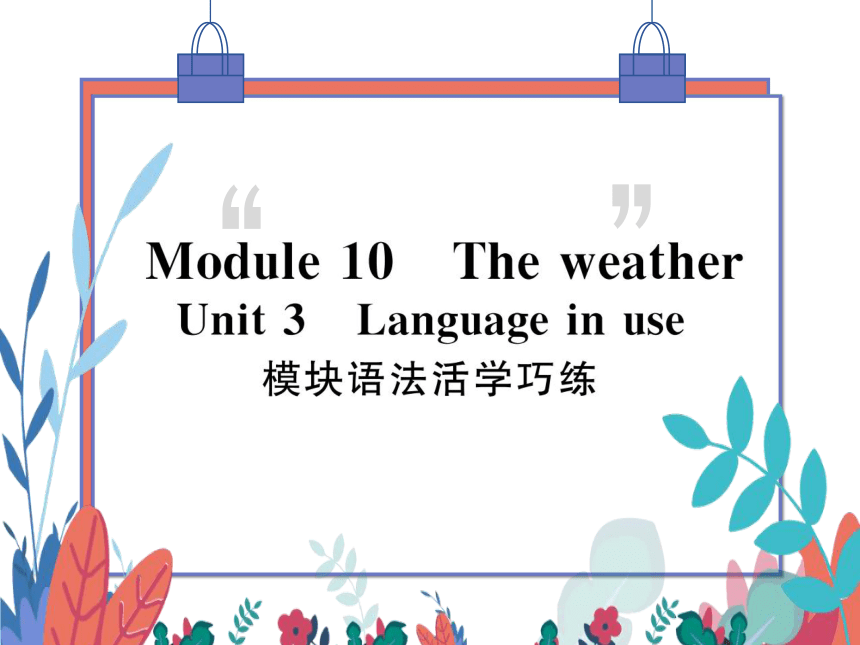 | |
| 格式 | pptx | ||
| 文件大小 | 2.1MB | ||
| 资源类型 | 试卷 | ||
| 版本资源 | 外研版 | ||
| 科目 | 英语 | ||
| 更新时间 | 2021-12-07 09:21:50 | ||
图片预览

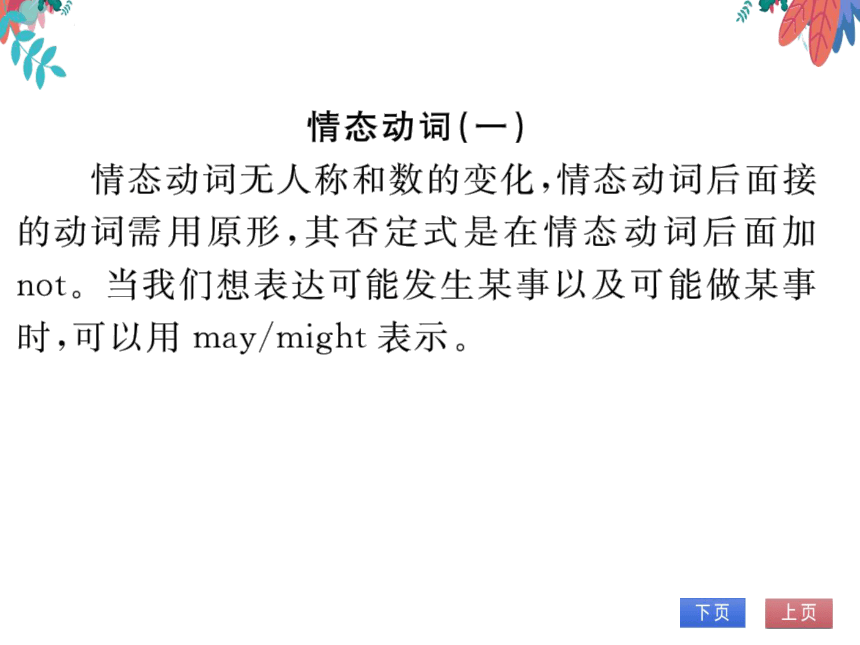
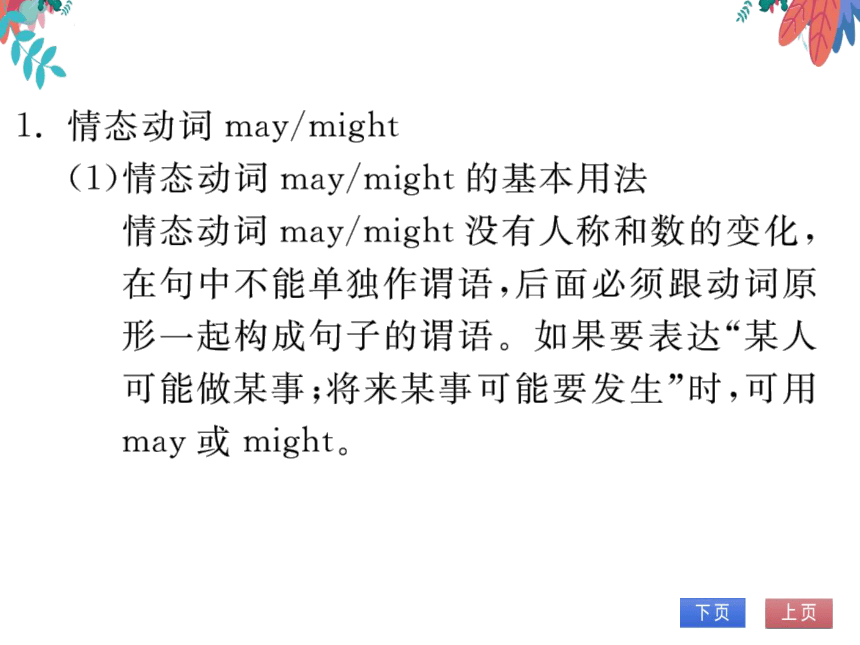
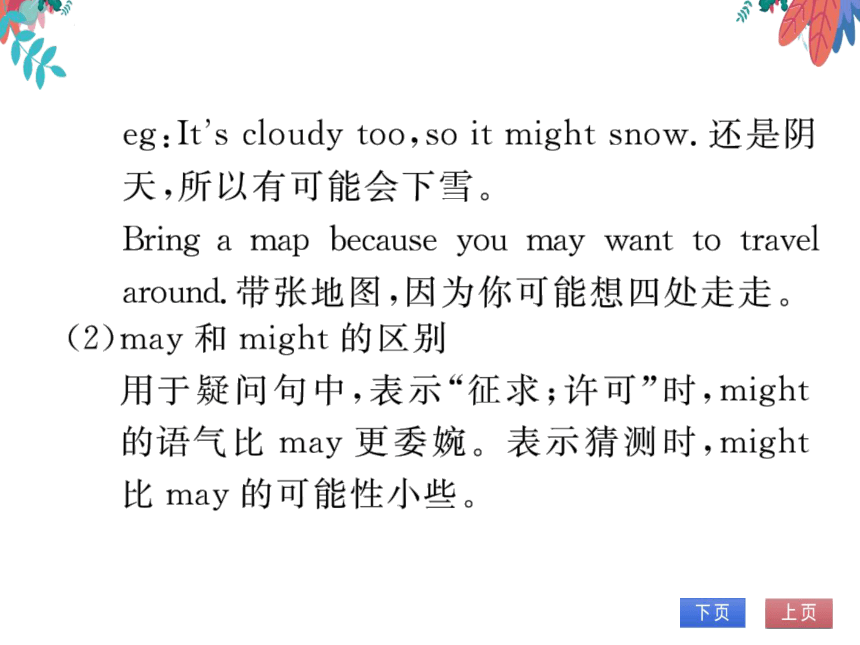
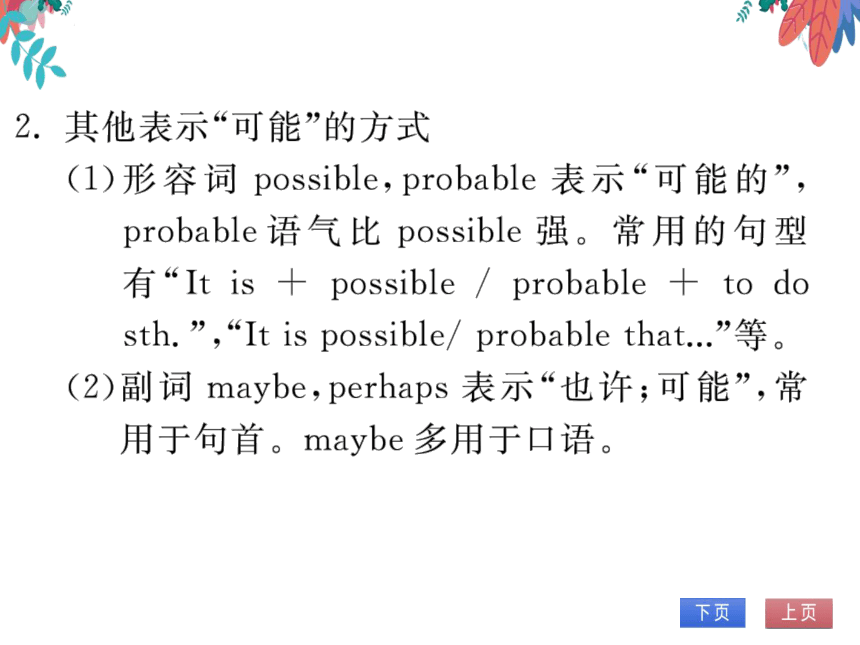
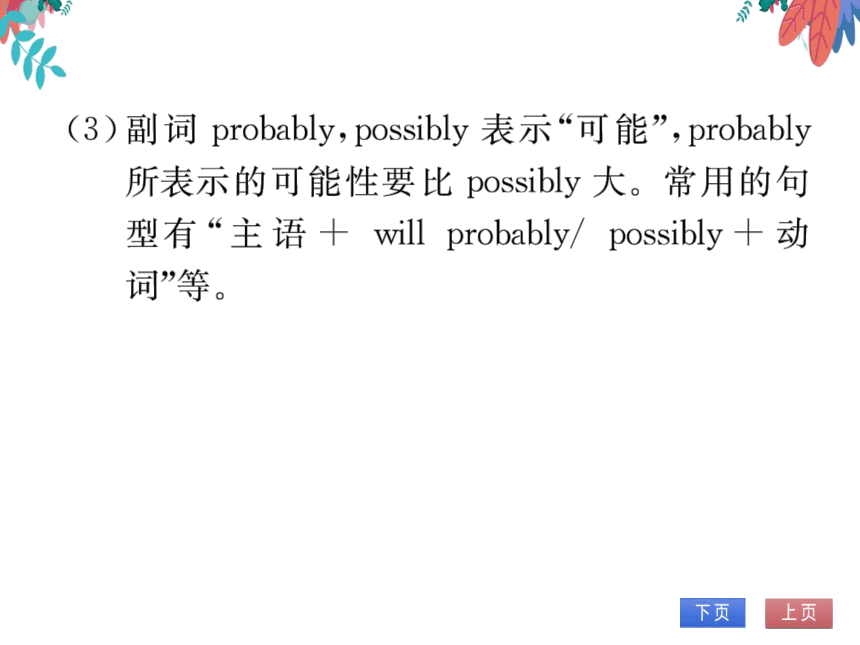

文档简介
(共16张PPT)
情态动词(一)
情态动词无人称和数的变化,情态动词后面接
的动词需用原形,其否定式是在情态动词后面加
not。当我们想表达可能发生某事以及可能做某事
时,可以用may/ might表示
1.情态动词may/ might
(1)情态动词may/ might的基本用法
情态动词may/ might没有人称和数的变化,
在句中不能单独作谓语,后面必须跟动词原
形一起构成句子的谓语。如果要表达“某人
可能做某事;将来某事可能要发生”时,可用
may或migh
eg:It' s cloudy too, so it might snow.还是阴
天,所以有可能会下雪
Bring a map because you may want to travel
around.带张地图,因为你可能想四处走走
(2may和 might的区别
用于疑问句中,表示“征求;许可”时, might
的语气比may更委婉。表示猜测时, might
比may的可能性小些。
2.其他表示“可能”的方式
(1)形容词 possible, probable表示“可能的”,
probable语气比 possible强。常用的句型
有“Itis
possible/ probable
to do
sth.”,“ It is possible/ probable that.等
(2)副词 may be, perhaps表示“也许;可能”,常
用于句首。 maybe多用于口语。
(3)副词 probably, possibly表示“可能”, probably
所表示的可能性要比 possibly大。常用的句
型有“主语十 will probably/ possibly+动
99
单项选择。
(D)1.(凉山州) Parents
put the things
like knives and medicine away in the
house to keep children safe
A
ay
B. might
C
can
D. should
(B)2.(哈尔滨)
I take photos here
No, you mustnt. Dont you see the
sign“ NO PHOTOS”
ou
B. May
C. Must
eed
(B)3.(齐齐哈尔)
I finish my work
now
O·VOu
You can do it later
A. May; neednt
B. Must: dont have to
C. Can: couldnt
D. Must: cant
情态动词(一)
情态动词无人称和数的变化,情态动词后面接
的动词需用原形,其否定式是在情态动词后面加
not。当我们想表达可能发生某事以及可能做某事
时,可以用may/ might表示
1.情态动词may/ might
(1)情态动词may/ might的基本用法
情态动词may/ might没有人称和数的变化,
在句中不能单独作谓语,后面必须跟动词原
形一起构成句子的谓语。如果要表达“某人
可能做某事;将来某事可能要发生”时,可用
may或migh
eg:It' s cloudy too, so it might snow.还是阴
天,所以有可能会下雪
Bring a map because you may want to travel
around.带张地图,因为你可能想四处走走
(2may和 might的区别
用于疑问句中,表示“征求;许可”时, might
的语气比may更委婉。表示猜测时, might
比may的可能性小些。
2.其他表示“可能”的方式
(1)形容词 possible, probable表示“可能的”,
probable语气比 possible强。常用的句型
有“Itis
possible/ probable
to do
sth.”,“ It is possible/ probable that.等
(2)副词 may be, perhaps表示“也许;可能”,常
用于句首。 maybe多用于口语。
(3)副词 probably, possibly表示“可能”, probably
所表示的可能性要比 possibly大。常用的句
型有“主语十 will probably/ possibly+动
99
单项选择。
(D)1.(凉山州) Parents
put the things
like knives and medicine away in the
house to keep children safe
A
ay
B. might
C
can
D. should
(B)2.(哈尔滨)
I take photos here
No, you mustnt. Dont you see the
sign“ NO PHOTOS”
ou
B. May
C. Must
eed
(B)3.(齐齐哈尔)
I finish my work
now
O·VOu
You can do it later
A. May; neednt
B. Must: dont have to
C. Can: couldnt
D. Must: cant
同课章节目录
- Module 1 How to learn English
- Unit 1 Let's try to speak English as much as possi
- Unit 2 You should smile at her.
- Unit 3 Language in use .
- Module 2 My home town and my country
- Unit 1 It's taller than many other buildings.
- Unit 2 Cambridge is a beautiful city in the east o
- Unit 3 Language in use .
- Module 3 Sports.
- Unit 1 Nothing is more exciting than playing tenni
- Unit 2 This year we training more carefully.
- Unit 3 Language in use .
- Module 4 Planes, ships and trains .
- Unit 1 He lives the farthest from school.
- Unit 2 What is the best way to travel.
- Unit 3 Language in use .
- Module 5 Lao She Teahouse.
- Unit 1 I wanted to see the Beijing Opera.
- Unit 2 It descibes the changes in Chinese society.
- Unit 3 Language in use .
- Module 6 Animals in danger.
- Unit 1 It allows people to get closer to them .
- Unit 2 The WWF is working hard to save them all.
- Unit 3 Language in use .
- Revision module A
- Module 7 A famous story
- Unit 1 Alice was sitting with her sister by the ri
- Unit 2 She was thinking about her cat.
- Unit 3 Language in use .
- Module 8 Accidents
- Unit 1 While the car were changing to red, a car s
- Unit 2 I was trying to pick it up when it bite me
- Unit 3 Language in use .
- Module 9 Population
- Unit 1 The population of China is about 1.37 billi
- Unit 2 Arnwick was a city with 200,000 people.
- Unit 3 Language in use .
- Module 10 The weathe
- Unit 1 It might snow.
- Unit 2 The weather is fine all year round.
- Unit 3 Language in use .
- Module 11 Way of life
- Unit 1 In China ,we open a gift later.
- Unit 2 In England, you usually drink tea with milk
- Unit 3 Language in use .
- Module 12 Help
- Unit 1 What should we do before help arrives?
- Unit 2 Stay away from windows and heavy furniture.
- Unit 3 Language in use .
- Revision module B
